
It’s rainy season here in the Philippines. It’s high time to stay indoors, watch TV, and sleep the day away, right? Wrong! For us and many other adventurers, that is a no-no. That moment when the skies become dark, nimbus clouds roll in, and the heavens weep in misery is actually a gate to try out new adventure! Heavy rains bring quiet rivers to life, creating fast highways that become playgrounds for rabid adrenaline junkies. In fact, during this rainy season, we had a dream adventure come true—whitewater kayaking in the roiling, angry waters of the Tibiao River.
Kawa Inn provided us with a good, hot breakfast of eggs, hotdogs, and dilis (fried salted anchovies), a breakfast perfect for a rainy day like this. After the meal, we headed to the Tibiao municipal hall pay Mayor Gil Bandoja a courtesy visit.
We love visiting poblacions like the ones in Tibiao. Virtually each municipality, town, or city in the Philippines has a poblacion, which is the traditional central business district of the area. A strong and concrete evidence of heavy Spanish influence, a poblacion typically has a plaza mayor, a church with a convent, a set of civic or government buildings, a school, and a public market.

With the courtesy call completed, we headed to Barangay Tuno high in the uplands of Tibiao. We could hardly contain our excitement when Sir Flord said that we were going to try out an extreme outdoor activity. That activity turned out to be whitewater kayaking!
We have always wanted to try this speed-manic adventure ever since we tried whitewater rafting in Cagayan de Oro a few years ago. Unfortunately, all the Cagayan de Oro-based outfitters whom we contacted do not offer white water kayaking.
But here in Tibiao, Antique, we saw our chance to try out this awesome adventure.

After fitting our PFDs and helmets, choosing our kayaks, and meeting our guides, we headed to a trail that goes up the river.
It was raining moderately, but the sun broke through briefly. The interaction between the sun’s heat and the wet ground released an earthy, evocative, and sweet smell that was totally pleasant.

A quarter of an hour later, we reached our starting point. We could actually hear the river’s noisy roar, confirming its immense power. The sound was a stark contrast to the peaceful scenery of lush hills that hug alongside the river.

Behold the mighty Tibiao River! It boasts of clear, clean, fast-flowing water that is perfect for kayaking and rafting. The Tibiao River is also a main artery for life; it is one of the region’s main sources of water to irrigate the farms in
Check out our sit-on-top kayaks; they are made of durable, industrial-quality fiberglass. Their sturdy material and construction allow them to withstand heavy impacts against boulders or the rocky riverbed.

Our experienced guides from Kayak Inn taught us how to paddle and ride the kayak in fast and churning whitewater. This is totally different from paddling in still, calm water. We really had to take all their instructions in because we opted to ride each kayak alone rather than in tandem.

Without warning, dark, gray clouds quickly reclaimed the sky. Rain began to fall, not in gentle drops but in heavy sheets! The downpour made river churn faster. Will we make it through Mother Nature’s temperament?
With the briefing finished, some of our guides took their positions in various sections of Tibiao River. In case something untoward happens, they were there to help fallen paddlers.

Once the guides were in position, the farthest one gave us the go signal. We got on our kayaks and entered the fast-flowing highway of water.

It didn’t take long for us that whitewater kayaking required an considerable amount of “feel.” Yes, to successfully make the kayak go where you want it to go, you need to be “one with the vessel” and interpret or counteract its whims.
For instance, too strong or too deep a stroke causes the kayak to swerve too tightly to the opposite direction. Too shallow and the boat won’t turn at all. Even putting your weight on either side of the vessel turns it to that direction. Feathering your oars is a skill that you must master quickly!
The strong current added to the challenge.
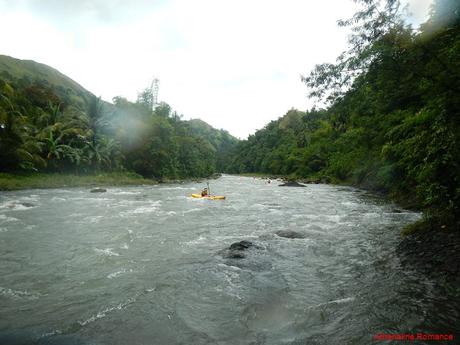
But, oh boy, did we have a lot of fun—a massive amount of it! Just look at Sweetie; she’s having the time of her life!
We were simultaneously trying to get our kayaks to where we want them to be, trying not to overturn, learning the exigences of whitewater paddling in the space of a few seconds, and following the signals of our guides!

We found a pocket of calm water near a small jetty where we can take a rest. According to our guides, this is an ideal practice for safety in whitewater kayaking.
If there are uncharted rapids ahead or if you are not sure if you can handle such rapids, you need to pull over to a jetty. Then head off on foot to an overlooking spot where you can safely study and check the rapids.
During the course of our adventure, we had three stops like this.

After the guides re-positioned themselves, we launched off the jetty and paddled farther down the river. Because they taught us a few tricks and techniques during the break, we were somewhat able to control the kayaks better.

But some parts of Tibiao River are annoyingly challenging—and shallow. There we were, riding the fast, strong current effortlessly like a jet. Our adrenaline pumped nonstop. Then usually without warning, our kayaks abruptly stop with a sickening, gurgling sound as they run aground on the stony bed!
We had to use the paddles as poles to laboriously push ourselves to deeper water so we could float again.

Just look at how powerful the water is! Recent rains have significantly boosted the river’s strength, a far cry from being a tranquil stream during the summer season.
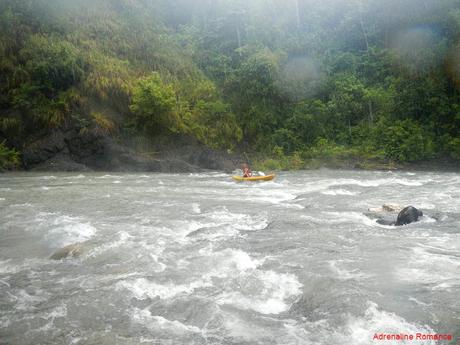
Go, Sweetie, go! She and our other team mates quickly learned how to maneuver in the rapids.
The beautiful Tibiao River is considered to be one of the best whitewater rivers in the country. In fact, in 1997, the first International Kayaking Cup, initiated by Tibal Adventures, Inc., was held here. Since then, the waterway became a favorite venue for both local and international paddlers and rafters.
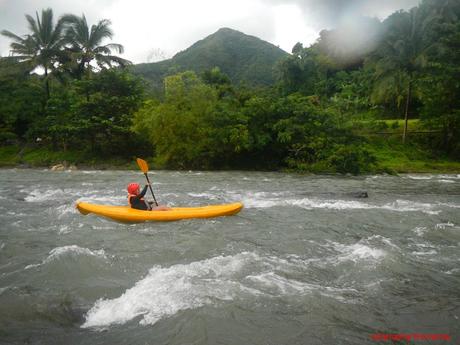
The large boulders that jut out of the river at certain places act as obstacles. It takes quick reflexes to maneuver around them.

Mother Nature is anything but uniform; and the Tibiao River is a perfect example of her chaotic nature. The different geological characteristics of the waterway causes various grades of churning rapids, ranging from Class 1 to Class 4, to exist. Thus, there are various grades of difficulty for everyone, from nervous beginners to daredevil professionals.
Here, Sweetie tries to navigate a Class 3 rapid.

Come on, Ivan, fight through it! It can be an exhilarating challenge, a heart-pumping scare, or a real life-and-death scenario if you get caught in strong rapids.
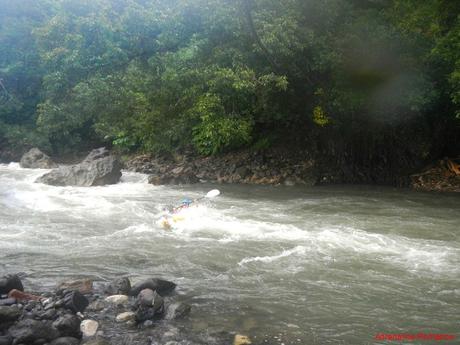
Don’t worry if you feel you the rapids are too much for you. A guide can help you accomplish the challenge.

At the last stage of the adventure, Sweetie’s kayak suddenly overturned after it got hit by a submerged rock as the boat swept sideways. Both she and the kayak rode the rapids (good thing she was wearing a PFD) until she reached a guide who was standing on a large rock in the middle of the river.
Water is not Sweetie’s element, but despite the potentially hazardous mishap, she was calm and composed. In fact, the moment she safely stepped on the rock, she laughed off her fall while my heart pounded heavily with concern, knowing she couldn’t swim.

All too soon, the adrenaline-pumping ride was over, and we arrived at the exit point. One of the guides took me aside and told me that my paddling skills are enough for a more advanced run beyond this point. Whoa! I would definitely do that on our next trip here.

Good job, team! And thank you so much, Kayak Inn guides, for making our whitewater kayaking adventure super enjoyable.

The Full Power of Bugtong Bato Falls
Our physical exertion, adrenaline, and excitement made us feel terribly hungry. We couldn’t wait to get to Blue Wave Traveler’s Inn and Resto Grill (now renamed to Tuno Highland Inn and Resto Grill) where our gracious sponsors prepared a midday meal of hot and spicy chicken tinola, grilled tuna, and various vegetables. Perfect for a cold, rainy day!
Looking at the photo below, you might realize that there’s something oddly familiar about the place. Well, that’s because we’ve been here last summer. If you recall, we enjoyed a traditional breakfast and a relaxing hot kawa bath in this very place after our arduous climb up Mt. Guiting-guiting.

After having a satisfying lunch, we started a 30-minute trek to our next destination, the tall and mighty Bugtong Bato Falls. To our pleasant surprise, our previous local guide Joy was assigned to us! We never expected we would see this bubbly woman again.
As we trekked through the familiar trail, we noticed that the vast rice fields, the coconut groves, and the lush trees that hug the hillsides have become greener and healthier than usual. Rain, a gift from the heavens, is truly life-giving.

When we first visited Bugtong Bato Falls last summer, the water was a trickle. But in the middle of the rainy season, the waterfall let out a thunderous roar. The power of the falls is so immense that we can feel a strong, continuous rush of displaced air as the water hits the pool. In addition, the undercurrent is so strong that swimming in the normally placid pool is quite dangerous.
We would have wanted to visit the second and third tier of Bugtong Bato Falls, but Joy said it was not allowed at this time due to the danger of falling rocks and landslides the rain may cause.

Kawa Hot Bath at Kayak Inn
Before we had lunch, the owner of Kayak Inn, an Australian professional named Greg Hutchinson, asked us if we want a second run at whitewater kayaking after we visit Bugtong Bato Falls. This time, he will teach us intermediate techniques so we can maneuver the kayaks better. Sweetie and I unhesitatingly said yes, and we looked forward to another adventure.
Unfortunately, the unceasing, heavy rain made the river swell until it became a strong flash flood. We don’t have the skill to ride the rapids of this magnitude, so Greg called off the second run. Understandably, we were disappointed, but safety should come first.

To make up for the adventure, he set us up a relaxing kawa hot bath right. A kawa hot bath is a traditional hot water bath that involves you being boiled alive (kidding! Warmed is the more appropriate term) in a man-sized wok. Flowers, herbs, and leaves are then added to the hot water, giving off a citrus, fragrant smell.
Several establishments in Tibiao offer kawa hot baths, but what makes Kayak Inn’s service unique is that their kawas are positioned on a ledge that overlooks Tibiao River and the hills beyond. With a picturesque scene in front of you while being embraced with a comfortable warmth, it’s the ultimate way to relax!

Ah, this is the life!
Originally, the kawas are vessels used to process molasses. They fell into obscurity when more modern and technologically advanced methods of molasses processing were introduced. It was only relatively recently that they found a new use as wood-fired bathtubs.

(Photo credit: Jessica Ayun)
Tibiao Butterfly House
Thoroughly relaxed and rejuvenated after a harmonious blend of adrenaline and rejuvenation, we went to our next destination, which is just a 5-minute drive away from Kayak Inn. The privately run Tibiao Butterfly House, as its name suggests, cultures and conserves endemic butterflies.
Its facilities include a netted and protected sanctuary for newly hatched butterflies, a caterpillar and cocoon nursery, and a wall clock shop (dead butterflies are collected and used to decorate clocks).

They have cultured several species, but for some reason, the two netted butterfly houses only consisted of black and red metalmark butterflies. They’re still beautiful though.

They also showed us young caterpillars that are about to encase themselves in a chrysalis, a part of their life cycle. After a complex metamorphosis, these ugly creatures will become delicate and dainty butterflies.
Caterpillars are vulnerable to lots of predators such as birds and parasites such as wasps. Without protection, only a very small number of these caterpillars will survive in the wild.

Pottery Making
After admiring the pretty and jittery butterflies, we headed to a quaint village hidden behind a checkerboard of vast rice fields. Somewhere in this village was a humble, open-air shed. What secrets are in this ramshackle structure?
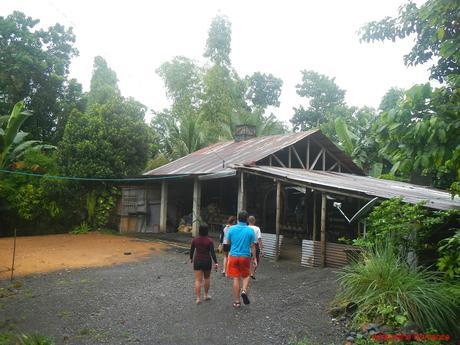
It turned out to be Tibiao’s main pottery shop. No, we’re not talking about machine-made pots. We are talking about splendid, traditionally handcrafted vases, pots, ash trays, plates, decors, and other vessels! These are lovingly made by artists who have devoted entire lifetimes in perfecting their craft.
Instead of an electric potter’s wheel, Tibiao’s craftsmen use hand or foot-powered wheels to shape balls and wads of clay to usable items.

Here are some of their finished products, ready for delivery. They look gorgeous, don’t they?

Aside from pottery, they also manufacture bricks. These are not the fragile hollow blocks and cement bricks of today that can easily be damaged or destroyed by a good whack. These bricks become solid as stone after they are thoroughly dried.

This quiet and stern old guy demonstrated to us how they make such solid bricks. He first placed a large chunk of fresh, moist clay on the mold and covered it with a sack. He then gave it a few good, solid, loud whacks that made us cringe. Probably squeezed the living soul out the clay.
After leveling off the excess clay, he ejects the still-wet brick out of the mold.

The bricks are then air-dried to let moisture evaporate. But the surrounding humidity means that there is still a lot of moisture retained even in the driest bricks. Too much moisture results in pieces that crumble easily.
To thoroughly dry and significantly strengthen the bricks, the air-dried pieces are cooked for several hours in this monstrous brick oven. Rather than wood, dried rice husks left over from the milling process are used to fire up the oven. The husks produce a longer, hotter fire than wood, sawdust, or coconut husks.
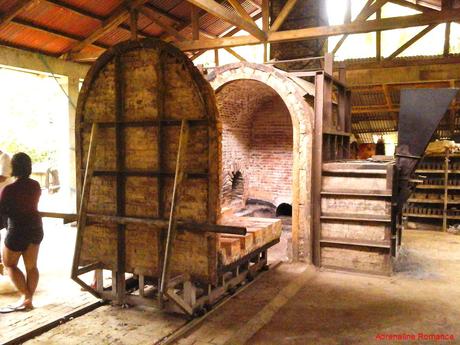
For dinner, we had an authentic pizza and pasta dinner at the Mammamia Italian and Filipino Restaurant run by chef, restaurateur, and now-Tibiao-resident Daniel Orsini. We had a true taste of real Italian pizza because all the ingredients used in the dishes are all imported straight from Italy!

The rainy season is not a flimsy excuse to stay indoors, sulk, and wait for the sun to shine. On the contrary, it’s a perfect time to venture out and try new adventures.
Visit Tibiao, Antique where rains and cloudbursts are sought after. In this part of Antique, the rainy season is the best time to get your adrenaline pumping!

Contact Details
To facilitate your tour around Tibiao, Antique, get in touch with the following:
- Mr. Junneth B. Dela Cruz (Sebaste Tourism Officer) – 0912-0915- 0925751
- Mr. Flord Calawag (OIC Antique Provincial Tourism Office) – 0927-699-5727 / 0919-813-9893
- Ms. Jola Lyn Tingson (Antique Natural Tourism Program Head) – 0977-811-0017
We strongly recommend contacting any of these officers before your trip so they can coordinate with the accommodation providers and the necessary people to help you in your adventures. They are the best people to go to if you want your adventure to be smooth-sailing.
Once you arrive in Tibiao, head first to the municipal hall to register. Then see the tourism officer/staff for assistance.
Rates*
Transportation (same rates apply on the return trip)
- P 120 per person – bus fare from Kalibo City to Tibiao
- P 180 per person – bus fare from Iloilo City to Tibiao
- P 30 per person – van ride from Culasi to Tibiao (if you decide to stop by, stay, or have a side trip in Culasi)
- P 70 per person – habal-habal fare from Tibiao to Tuno
Tibiao Related Fees
- P 50 per person – Tuno Ecotourism Association registration fee
- P 700 (basic short distance) to 2,000 (long distance) per person – Whitewater kayaking (ask Kayak Inn for breakdown)
- P 150 per group of 5 people– guide fee at Bugtong Bato Falls
- P 200 to 500 – Kawa Hot Bath (rates depend on the establishment)
* Rates are subject to change without prior notice. We did not include our expenses for meals, snacks, souvenirs, accommodations, tips, and other fees in this rate sheet as you may have different needs, preferences, itineraries, and sharing scheme from us.
Tips
1. For large groups or for a more private tour, you can hire an air-conditioned van from Southwest Tours. Use the following contact details:
- Cellphone Numbers: 0917-568-2441 or 0947-891-1658
- Email: [email protected]
2. For accommodations in Tibiao, stay at the Kayak Inn. Get in touch with Mr. Edwin or Ms. Shiela Endrico, Resort Managers. Use the following contact details for bookings, reservations, and information.
- Mailing Address: Barangay Tuno, Tibiao, Antique
- Mobile Numbers: 0921-5702947 / 0998-9993049 / 0922-7014648
- Email: [email protected]
- Facebook Page: Kayak Inn
- Website: Tribal Adventures
Whitewater Kayaking
3. Listen intently to the guide as he gives you a briefing. Whitewater kayaking is considered an extreme sport, which means it can be dangerous. Remember, you are dealing with a strong, fast-flowing river so your safety is of primary importance. Your guide will tell you how to hold an oar properly, how to paddle the right way, what to do in case you fall, what to do in case a team-mate falls, how to position yourself if you fall to avoid crashing into the rocks, etc.
4. Avoid hassles and ensure security by leaving the things you don’t need at the Kayak Inn. You can get them back after your adventure.
Kawa Hot Bath
5. There are plenty kawa hot bath providers in Tibiao, each with its own formula, gimmick, rates, and more.
6. Avoid scalding yourself by entering the hot kawa slowly to allow your body to gradually adjust to the heat.
7. Ask the provider to rekindle the fire if the water becomes lukewarm.
8. The water in the kawas are drained after each customer to practice good hygiene.
Bugtong Bato Falls
9. Although going to Bugtong Bato is an easy trek, the barangay requires visitors to have a guide, which are available (through rotation) at the barangay outpost.
10. Wear sturdy trekking sandals or shoes.
11. Be careful when climbing or going down boulders and the steep stairs towards the second tier.
12. Use the fixed rope to carefully ascend the tiers.
13. Do not do any high dives! The water under the waterfalls is quite shallow in many places.
14. Going to the higher tiers is not permitted when it is raining heavily.
Additional Tips
15. Pack light but do bring the following
- booties
- trekking sandals or shoes (for trekking)
- dry-fit clothes
- trekking shorts or pants
- rash guard, swim wear
- cycling shorts, bathing trunk,
- water or juice (at least a liter)
- snacks
- sunglasses (if possible, equip them with a strap)
- plastic bag (to put your garbage in)
16. Waterproof your stuff by wrapping them in plastic bags before putting them in your backpack.
17. Do not litter, and bring all your garbage with you. Do not vandalize.

